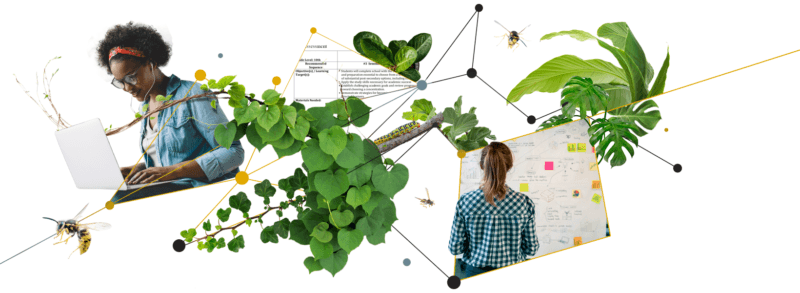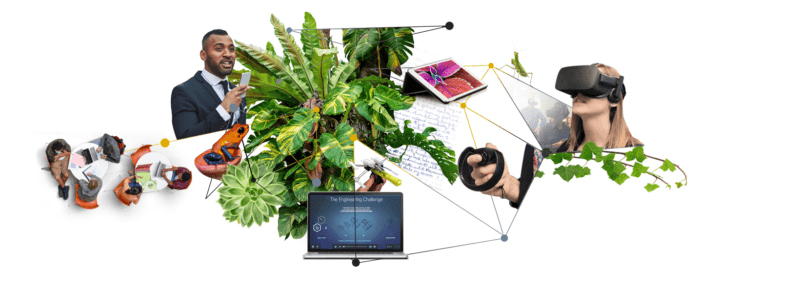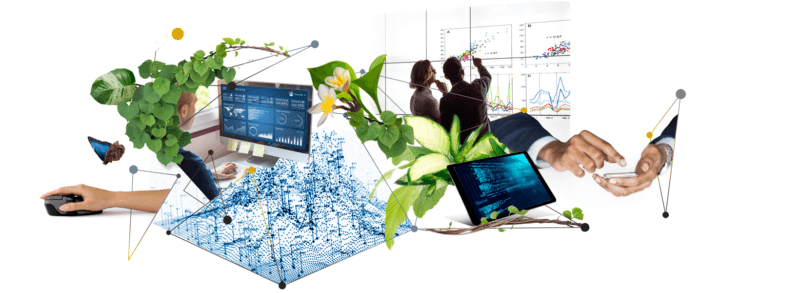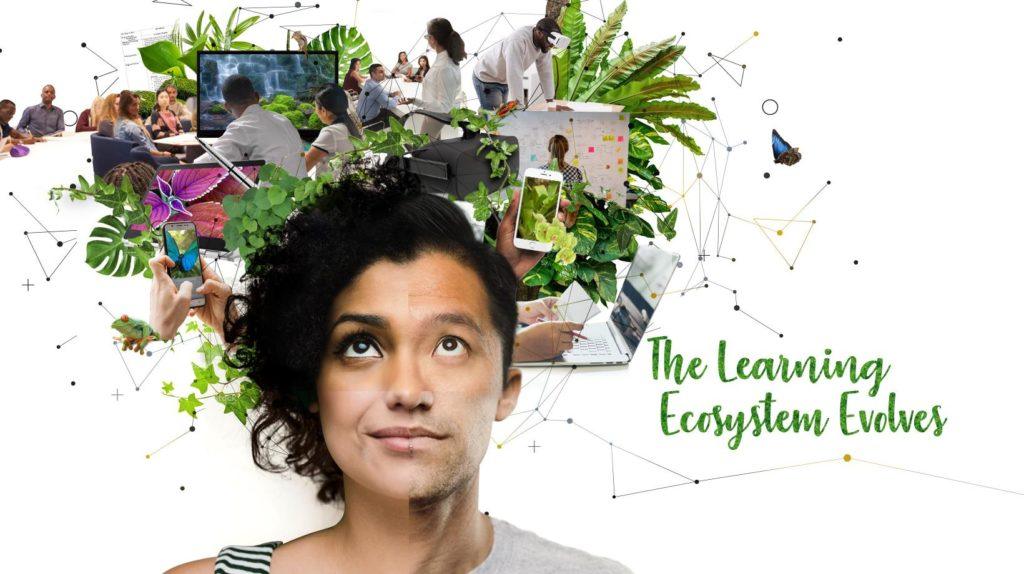2019 Instructional Design Trends And Learning Trends You Should Adopt
Recently, one of the biggest shifts in L&D thinking is that workplace learning can be considered an ecosystem. Not a random collection of courses and workshops and webinars, but a complex, integrated system of formal and informal learning. Learning is not an event, but a journey. Every moment we take in information—from media, from our peers, from content an organization controls and content it does not—is a step in that learning journey.
A second major shift is designing learning in a way that is learner-centric; this has been known about for years and is now at a tipping point. Yes, you need to align with the business objectives, and you need to engage learners to keep their attention and focus.
From where we sit as vendor-partners and learning solution collaborators for some of the world’s most fascinating, innovative, and dynamic companies, we have an interesting vantage point. We’re looking across the industry, engaging with a wide spectrum of L&D leaders. We’re seeing what excites them and, frankly, frustrates the heck out of them. And we share this excitement and frustration.
As we think about 2019 Instructional Design trends and learning trends, though this might be a radical concept, our first thought is not about solutions. Instead, we’re thinking about the sticking points. The challenges. Those areas that are holding the ecosystem back from evolving.
We’ll get to those sticking points in just a moment. But first, it’s important to consider the context for them. What’s driving these changes in L&D?
- The Focus On Culture And, In Particular, Building A Culture Of Learning
If that’s the goal, don’t the learning experiences we’re offering have to get people excited about learning and be respectful and inclusive? - The Shift In Generations In The Workplace
Millennials and Gen Z are telling us that training and career advancement opportunities mean more to them than even their salaries. - The Way Work Is Done Is Changing And Becoming More Collaborative
This puts more focus on team cognition, performance feedback, and enabling social and informal learning. - Learning Can No Longer Be Only A Thing You Do Outside (Or In Addition To) Your Daily Work
You need it at your fingertips when you need it most; learning in the flow of work, always accessible - There’s A Heightened Emphasis On The Transfer Of Learning Back On The Job
This is impacting learning design (more performance-based) and measurement and evaluation. - Technology Continues To Be More Affordable, Accessible, And Ubiquitous
Artificial Intelligence is part of our daily lives. Virtual Reality, Augmented Reality, mixed reality, and mobile apps are emerging tools in L&D’s tool chest, ready to be put to use in the right circumstances.
2019 Instructional Design Trends And Learning Trends: From Sticking Points To Solutions
Come along for the ride with us, and let’s take a look at some sticking points in the ecosystem, and the solutions that are emerging and shaping our 2019 Instructional Design Trends and Learning trends. As these solutions come into the mainstream and are integrated within the whole, we’ll see L&D shedding its skin, and emerging with vibrant colors that will attract talented professionals who will help continue this evolution!
The graphic below highlights the key points you’ll find in this article, so feel free to skip around and look at the trends that interest you most (hello autonomy!).
Sticking Point 1: One-Size-Fits-All Learning
Evolution: Adaptive Learning, Personalization, Design Thinking, Learner Experience Design, Interaction Data/xAPI/Clickstream Analysis, User-Generated Content

Learners are individuals, not clones. The people who take your courses attend your workshops, or pop on a VR headset to take your training, bring different backgrounds, experiences, and prior learning to the table. So why give them all the same learning experience? Is it because it’s hard to give them something personalized?
Not as hard as you might imagine, and we’ve been doing it for years before the term “adaptive learning” got coined. Testing out? Content specific to your role? Detours? Branching scenarios? We asked our team, “Why has this become the trend that tops everyone’s lists?”.
A resounding answer was the shift in generations in the workplace. John-Carlos Lozano, SweetRush’s Chief Creative Officer, says of Millennials and Gen Z:
“Everyone wants something that’s custom for themselves. If it’s unique—special for me—it’s seen as more valuable than things that are mass-produced where everyone gets the same thing. Marketing messages are geared toward this: It’s speaking to you, it knows what you want”.
There’s an L&D mind shift at play here as well. In the past, identifying a performance gap happening in a given role meant everyone got trained; today, there’s more focus on training and upskilling according to individual needs.
“It’s actually more efficient to train people only on the things they need, rather than on everything”, said Lozano.
Additionally, advances in technology make assessing individual learners’ prior knowledge and competencies easier, as well as giving them access to the learning they want and need. Artificial Intelligence built into learning systems (LMSs, LXPs) can serve up personalized recommendations for learning experiences and intelligent learning paths.
While technology can make the serving up the right content easier and more intuitive, it’s important to remember that effective adaptive learning “is not borne on the strength of the technology or the AI, it’s the strength of the content analysis”, says John Cleave, Ph.D., Learning Technologist at SweetRush. With that in mind, consider the trend of Instructional Design shifting, in both title and the nature of the role, to learner experience design. Techniques that come from design thinking, with its emphasis on empathy and walking in the user’s shoes, are becoming more common in upfront analysis and solution design.
Taking a page from marketing, the development of learner personas has entered the conversation. This consists of identifying different sub-groups of like-minded and like-experienced individuals within your target learner audience and adapting the learning experience to meet the needs of each sub-group. That might mean customizing the learning path, intro course (and WIIFM), scenarios, supporting materials, etc. There’s more excitement about conducting empathy maps and learner focus groups as part of the analysis and solution design than in the past, which helps us challenge the assumptions we make about learners and get to the truth about how they want to learn.
Technology also allows us to look more granularly at how people interact with digital learning and use clickstream analysis to improve it. Which path do they take? Where do they get stuck? How can we add training wheels—or take them away—at the right moments? Tools and methods to analyze that interaction data are going to be key for successful pilots and updating learning programs to make them more effective.
Finally, we’re enabling more involvement from the learning audience themselves. User-generated content, from blog posts to how-to videos to podcasts, speak to learners with maximum relevance. In platforms with social learning built in, learners can pick and choose which content resonates with them and respond to it (comments, likes), offering a combination of tailored experience and human connection.
Sticking Point 2: Boring, Disconnected, Tedious Classroom Training
Evolution: Multiple Modalities, Blended Experiences, Activity-Rich Classrooms

Despite its frequent shortcomings, classroom training (or instructor-led training, or ILT) remains extremely popular with learners and organizations alike. We get it: Even if it’s awful, it’s a break from the day-to-day. And learners can potentially network, meet new people, and learn from others.
While classroom training is not going away altogether, shifting to online learning remains a strong need driven by cost savings and geographic dispersion of learners. Again, this isn’t a new trend; we’ve been converting ILT to eLearning for years. But the way we’re solutioning these efforts has evolved in new and interesting ways: less “conversion” and more “transformation”. The focus is on motivating learners, keeping them engaged, helping them connect with each other, and transferring skills back to the job.
It used to be that converting ILT to eLearning meant less ILT and some prework eLearning. Now we’re creating robust programs with multiple modalities: eLearning (mobile accessible, of course), self-reflection exercises, virtual Instructor-Led Training (vILT), team activities (live and virtual), role plays, coaching, action plans…unified by a shared learning space, gamification, and program branding and marketing and enhanced by social learning. Training Industry recently suggested shifting the term “blended learning” to “blended experiences” [1] and that feels like a nice evolution for our 2019 Instructional Design trends and learning trends.
When we do have a scenario in which classroom training is the perfect solution, well, RIP, death by PowerPoint. Today’s ILT should be an activity-rich learning environment, with games and simulations (analog and digital), and companion mobile apps designed to keep attention, push resources, and enable networking.
Sticking Point 3: Dull Webinar
Evolution: vILTs With Social Components, Live Audiences, Mobile Apps, Games

Uninspired stand-up lectures are bad enough in the classroom, but it’s a disaster in a virtual environment, where people have all kinds of distractions at their fingertips. Without an in-person facilitator to keep you accountable, c’mon: It’s just too easy to zone out.
Finding creative ways to incorporate the social and peer-to-peer learning that happens more organically in person, without it being a distraction or waste of time, seems to be the holy grail for vILT. While virtual meeting technology seems to be improving with some new players in the mix (hello, Zoom), how many facilitators still hold their breath when using breakout room functionality?
We’ve had more success with team activities and gamification, in which teams work together outside the virtual classroom to solve challenges, discuss concepts, role-play, and earn points. They then bring that team energy back into the vILT.
Mobile apps are coming into play here, too. Apps can push games and resources to learners before, during, and after the vILT experience, keeping learners engaged and connected. They can also provide opportunities for networking; one can access profiles of their classmates and reach out to them through the app.
Mixed environments are another potential solution, in which an actual classroom is filmed and live-streamed to virtual audiences, giving them more of a feeling of being in a classroom. The company Creative Live uses this strategy. Participants in the live classroom are introduced, along with their WIIFM for taking the class; hearing these relevant stories, virtual participants can see their live counterparts as stand-ins or avatars for themselves. They can also send in comments and questions that are read on air, pulling them to the live classroom through their participation.
Sticking Point 4: “Click Next” eLearning
Evolution: Performance/Practice-Based Simulations, Interactive Video, Storytelling, VR, AR, Mixed Reality

Transfer of learning to the job is on everyone’s mind (read more below under “Sticking Point 8: Smile Sheets”), so it makes sense that we’re seeing a stronger focus on practice and application in eLearning in our 2019 Instructional Design trends and learning trends, instead of simply dishing up knowledge in a basic page-turner or “click Next” course.
“If I had a dollar for every time someone said the words ‘choose your own adventure’, I’d be a rich woman”, said SweetRush Solution Architect Annie Hodson.
The fascination with these interactive paperbacks has enjoyed a resurgence with the recent release of Netflix’s Black Mirror: Bandersnatch, which offers the very meta-story of a coder working on a choose-your-own-adventure–style game…while you (the viewer) are presented with decisions that impact the characters. (You make the selections via your Smart TV/Roku/etc. remote control.)
Likewise, we’re seeing more excitement for practice-based simulations, using traditional web-based courses, interactive video, and Virtual Reality. To make sense of complex, branching scenarios, IDs are turning to new tools beyond the Word-based storyboard to create flowcharts and decision trees. And again, we have an opportunity to personalize the learning with adaptive techniques, offering more assistance in the form of “expert help” when needed, or taking off those training wheels for advanced learners.
The success of these efforts relies on exceptional storytelling, and the production capabilities to bring that storytelling to life. Avatars continue to be a cost-effective alternative to live video, and we’re seeing more depth and personality in their stories: human, flawed characters who learn and grow as the learning program progresses, rather than straight-up narrators. Learners see themselves in these stories, increasing emotional connection and relevance.
Richer characters mean that more care needs to go into audio production: voice talent is no longer just whoever’s free at the moment with a pretty good voice. The bench now includes professionals with comedic timing who can project emotion and directors who can bring out the best in these actors. Visually, showcasing diversity in organizations is shifting from simply a variety of skin tones to illustrating different body shapes and sizes, people with disabilities, and culturally and age-appropriate fashion. Attention to all these details elevates the learning experience.
VR and AR continue to be exciting developments, adding to our L&D tool chest. We’ve written extensively about VR and its uses in safety training, new hire onboarding, and empathy building (more on the latter below under “Sticking Point 10: We need our people to be more empathetic.”), based on our experience developing these programs. The VR trend to watch is interactivity: Learning experiences are always more engaging when we allow learners to get hands-on, but to do so requires integrating 3D within the experience, a capability many vendors do not possess.
For AR, we’re evolving beyond the classic “museum” scenario. Hold up your phone or tablet in front of a thing and get more information in real time, in a cool way. In a recent project, we combined AR, gamification, and 3D avatars to create an AR-enabled card game that demonstrates customer body language and teaches customer service skills. And, “think about the mix of Augmented and Virtual Realities, presenting various combinations of real and virtual objects in the same display”, says Andrew Kubay, Senior Learning Engineer at SweetRush, who predicts we’ll see mixed reality learning programs come to fruition this year.
When budgets and timelines don’t allow for more sophisticated learning experiences, we’re seeing other trends to add life and relevance to courses of every level. Interactive, nonlinear course maps increase autonomy and break out of the “click-next” box. Self-reflection moments target higher cognitive levels and are functionally very simple to create. A good story paired with a series of stock photos can trigger an “aha” moment.
Sticking Point 5: We Need It Yesterday! And It Has To Work Everywhere!
Evolution/Trend: More Options For Mobile/Responsive Design Tools For Rapid Development, Staff Augmentation

In just about every industry, there is a demand to produce faster, and means of production are evolving to keep up. Some of this is perception: An entire season of your favorite show is suddenly available to binge-watch, but trust, it wasn’t planned, filmed, and edited in a day. Even so, the world has sped up, and L&D needs to keep up. Hence the increasing need for rapid development solutions.
The other important piece in this puzzle is that mobile-accessible learning is no longer optional, it’s a must-have in 2019.
Out of this demand, supply has sprung and introduced new major players in authoring for rapid development: Evolve, Rise, and Flow are three names you may have already heard. Their already-high level of adoption is signaling a shift in the authoring field that was previously dominated by a few players.
We’re often doing our best to work with content that’s nowhere near stablε; as business processes are still being ironed out and brand and legal reviews are more frequently essential steps, we’re flying the plane while building it. That means our courses need to be easily updatable by vendor and client teams alike, which also extends shelf life. These tools meet that need as well.
With any tool that purports to make authoring easier and faster, there’s a natural tension as what you want to create butts up against the tool’s limitations. Consider techniques such as storytelling; there are always low-tech ways to delight your learners (see more above “‘Click Next’ eLearning”).
Tools aside, when you want to get something done fast, sometimes, it makes sense to limit the cooks in the kitchen. When rapid development is needed, we’re seeing a trend toward using a staff augmentation approach, in which we supply a client with a one-(wo)man-band Instructional Designer or Technologist who creates the program from start to finish. The end product is going to be different than one with a Creative Director, Graphic Design team, and Developer/Engineer attached, but when a project is smaller and not as complex, this is sometimes a viable path to meet your time-to-market objectives.
Sticking Point 6: Legacy LMSs With Rigid Structures And Bad UX
Evolution: LXPs, AI/Smarter Learning Paths, Career Development Tools, Credentialing

Does everyone hate their LMS? According to Docebo’s 2019 eLearning Trends Report, 43% of large organizations are looking to replace their LMS [2].
No shade intended to LMS vendors, but frustrations run deep: Learners struggle to find what they need, lost in unfriendly User Experience. L&D professionals lament not being able to offer a more engaging experience.
Others have written about this with more authority [3], but from where we sit, there’s an urgent need for better solutions. If we’re putting so much energy into creating engaging, effective learning programs (content), if we’re trying to create a culture of learning, shouldn’t the experience of accessing learning be exceptional, too?
Savvy LMS and Learner Experience Platforms (LXPs) vendors seem to be picking up on this need.
“The idea here is to track people’s learning no matter where it happens, to better understand what learners want and need, and to better design learning that delivers”, says Cleave.
Many are placing their bets on artificial intelligence to improve UX, whether that’s through creating smarter learning paths and recommendations, or content curation that blends the organization’s existing content, user-generated content, and outside sources into a one-stop shop for learning materials.
When it’s too challenging to change the LMS, organizations are looking at building other systems that offer an entry point to relevant learning. And at the same time, they’re setting their sights on another critical challenge in today’s tight labor market: talent retention. Within these career development tools, you might self-assess your strengths, share what types of work challenges you’re interested in, and be guided to other roles within the company you should consider. These can take you directly to learning opportunities that can help prepare you for that new role. Now imagine that experience within a mobile app…swipe left, swipe right, a new dream, new goal, let’s learn.
A natural question that arises from these tools is, how do we acknowledge when people have successfully completed learning programs (and, even better, can demonstrate that they can use those skills successfully on the job)? How does that become part of their “profile” that they can carry with them as they apply for new positions? And, a step further, even when they change companies?
Blockchains have entered the conversation on this front, as a way to record and track engagement in learning events in the same way data is retained as an asset moves through a supply chain. This is also the purpose of third-party credentialing systems like Credly, which enables learners to earn badges and other credentials as they engage in different tasks and learning. It will be interesting to see how this evolves as a 2019 learning trend.
Sticking Point 7: Worrying About Learning Retention
Evolution: Learning Built Into The Workflow, Microlearning, VR, Learning Artifacts

Let’s connect back to the premise that learning is a journey. If we, L&D professionals, are the guides along that journey, we need to offer resources that trigger travelers to remember what they learned and allow them to quickly refresh and learn in the flow of work.
The flagship solution for point-of-need learning is microlearning, or chunking learning into small bites of a few minutes that someone can quickly access at the moment they need it. The challenge is that you don’t want a bunch of bite-sized learning units floating around with no easy way to access them. Here again, AI and in particular chatbots/intelligent assistants may be part of the solution, allowing learners to ask for what they need (“how do I”) and receive learning materials in response—a natural extension of conversational search in Google or YouTube, but with results limited to the organization’s offerings. We’ve had success with this approach and clients seem to love it.
Now all that said, we may just have a whole new ball game at play here, and that’s Virtual Reality. Does the “forgetting curve” change if they learn in a different way—a completely immersive way—in the first place? A study by the University of Maryland suggests that recall may be higher with VR [4]. And the logic is there: You’re completely blocking out all distractions. That said, this study is about the recall of knowledge, not necessarily the ability to perform in a certain way on the job. Yet on that front, too, with VR you can get as close as possible to actually performing the work hands-on, which makes the transfer more likely.
For something completely different, let’s talk about artifacts. Culture guru, Edgar Schein, wrote about artifacts back in the ‘80s: tangible things that, when we see them, help connect us to our workplace culture. Learning artifacts are a twist on this concept: could something that learners create during the learning experience, either by themselves or with a team, resulting in a tangible object that serves to remind them of that experience? That object then becomes a stand-in for or embodiment of the learning experience.
Still with us? Here’s an example: in a course designed for Engineers, we added a gamification element in that each time they finished a lesson, they “unlocked” part of the instructions to build a Star Wars X-Wing Fighter out of office supplies. They LOVED this—took pictures, posted them on the social learning platform, and every post got great reactions and comments. How many of them still have that moment on their desks? Probably quite a few. And it’s imbued with an association to what they learned, every time they see it.
Sticking Point 8: Smile Sheets Or…How Do We Know How Effective Our Training Is?
Evolution: Way More Focus On Learning Measurement And Analytics

As a vendor-partner, understanding the effectiveness of the learning programs we develop is essential to improving our own performance—recommending the right solution for the need, and developing it in a way that reaches the audience. And we’ve been fortunate to partner with forward-thinking L&D professionals who believe in evaluation as an essential part of the learning development process. It’s both exciting to hear what’s working and a good challenge to improve what’s not.
Still, it’s true that many organizations aren’t measuring…or aren’t measuring much. Maybe you’re doing so many things to move the needle on a KPI that it’s difficult to tease out what part of that can be attributed to learning? Is there maybe a lack of skills in this area internally? And maybe, most likely, it’s the easiest part of the budget to cut.
With the rise of Big Data and data analytics in all areas of the business world, the tide seems to be (finally) turning in L&D, with more of our clients interested in learning measurement and evaluation. And it looks like we may be evolving beyond the Kirkpatrick levels and seeing new models emerge. The 6Ds® takes a leap from ADDIE, offering a model for creating effective, holistic learning that includes measurement techniques to “prove and continuously improve training’s value” [5]. And Will Thalheimer’s Learning-Transfer Evaluation Model pays homage to the Kirkpatrick model and expands the suggested levels to eight, which distinguish learner perception, knowledge, competence, and transfer [6].
Learner confidence is emerging as a popular measurement that can give us one indication of training effectiveness [1]. We can get a baseline understanding of a learner’s confidence in his or her ability to perform a specific task, say, presenting a certain product to a client, and then reassess following the learning experience and see if confidence has gone up. As the renowned social cognitive psychologist, Albert Bandura said, “Self-belief does not necessarily ensure success, but self-disbelief assuredly spawns failure”.
Sticking Point 9: Inadequacy Of “Check The Box” Compliance Training In Today’s World
Evolution: Addressing Societal Issues (Data Privacy, Unconscious Bias, Harassment) In Authentic, Engaging Ways

Of all the workplace learning subject matter, compliance training has most often gotten the short shrift in creativity and engagement. It’s a legal requirement; we just need to check the box. Does anyone want to venture a guess how often negative perception of eLearning has stemmed from poorly designed compliance training?
Today’s world is one of heightened risk for organizations. Anyone can take out their cell phone and capture a video, and get it out to millions of people in a second on social media. Hackers are resourceful and connected, making it their full-time job to find security vulnerabilities. The stakes are higher than ever in the corporate world, and missteps (or worse) can instantly damage a company’s reputation and share price.
Organizations can no longer afford to roll out compliance training that makes your eyes glaze over. The shift here is a stronger emphasis on teaching decision-making and judgment within the key topics of the code of conduct, data privacy, unconscious bias, and harassment.
Let’s face it: you can’t possibly present every scenario that an employee might face within these topics. So you have to teach them to stop and think before they act, which can often be done through learning devices (Gen Xers, remember “Stop, drop, and roll”?). Of course, you’ll give them scenarios too, and those should feature authentic, compelling storytelling and situations that don’t have an easy answer. Learning should be as challenging as what they’ll face on the job, within a safe environment to practice, make mistakes, and learn.
Sticking Point 10: We Need Our People To Be More Empathetic
Evolution: Design Thinking, Virtual Reality, First-Person Point Of View

Helping employees build empathy for others has risen dramatically as a topic in workplace learning. While it’s always been an important area of personal and professional growth, “what’s happened now is that there’s enough of a roar that we’re hearing it”, said Clare Dygert, Director of Instructional Design at SweetRush.
And there are some solid reasons for this. “Design thinking has legitimized the need for empathy in making business decisions”, explains Dygert. We’ve already mentioned the focus on culture as a business imperative and social media raising the stakes on soft skills missteps. As learning professionals, we’re looking for new and better ways to help people walk in others’ shoes, see other perspectives, and make decisions with those perspectives in mind.
Virtual Reality has entered this conversation in a big way because at this point in time (before someone invents the holodeck), it’s the best way to see the world through someone else’s eyes. And by integrating 3D in VR, learners can also experience the physicality and complexity of others’ jobs. VR is often more cost-effective and less time-consuming than shadowing, and a lot more effective than a passive tour of someone else’s work environment.
Yet VR is not the only way to achieve the first-person point of view; the same can be done with other types of simulations (eLearning and analog). We just wrapped up a project that helps bank employees better understand their customers by taking them through the complicated decisions their clients face—by having them experience life as a client opening a restaurant. Location, rent, labor, insurance, cost of goods, menu, decor… So many interconnected decisions arise, and everyone’s got an opinion. Spend an hour in the simulation and it’s hard not to feel empathy for anyone trying to start a business.
Sticking Point 11: The Annual Review
Evolution: Continual Feedback, Performance Feedback Apps

The annual performance review has become an antiquated concept. Just as we need to be continuously learning in order to perform better in our work, we also need to be continuously receiving constructive feedback. This helps us pinpoint areas where we need to learn and grow and get reinforcement in the areas where we’re making an improvement.
It’s also important that feedback not just come from the top down. Some people are naturally good at “managing up”. But if a healthy culture is your goal, improving how people work together with their peers, their teams, and the people they manage or are managed by is vital.
To solve this need, there’s a lot of energy around performance feedback apps that make it easy for employees to give immediate feedback about each other. Look, memories fade, and feedback needs to be accurate to be most effective—so with these apps, we’re striking when the iron’s hot. Gamification and social learning can be integrated as well; employees can earn points for sharing their expertise and build reputations as experts in specific areas.
With the data from these apps, organizations can craft more relevant and useful learning interventions, and identify opportunities for growth and promotion as strengths become more evident.
2019 Instructional Design Trends And Learning Trends: Solving Challenges, Evolving Together
It’s now 2019, exactly one year before we’ll all have a clear vision. (That’s my 2020 joke. I’m here all year!)
Let’s skip the long wrap-up: Suffice it to say, 2019 should prove to be a very interesting year in L&D. As we often say, sincerely, how fortunate we all are to work in such a vibrant, dynamic field, with a mission to improve the lives of others through learning. Yes, we face tough challenges, but with the talent, intellect, and creativity in this field, we can overcome the toughest of them together.
Please, leave your thoughts on these 2019 Instructional Design trends and learning trends below in the comments, or reach out and share your thoughts personally. We’d love to hear from you!
References:
[1] Trends 2019: Adapting the Training Function to the Complexity of Today's Business Environment (https://trainingindustry.com/magazine/nov-dec-2018/trends-2019-adapting-the-training-function-to-the-complexity-of-todays-business-environment/)
[2] E-Learning Trends 2019 - by Docebo (https://www.docebo.com/resource/report-elearning-trends-2019/)
[3] The Learning Experience Platform (LXP) Market Expands
[4] People Recall Information Better Through Virtual Reality, Says New UMD Study
[5] What are the 6Ds? (http://the6ds.com/what-are-the-6ds/)
[6] The Learning-Transfer Evaluation Model (LTEM) (https://www.worklearning.com/2018/02/14/the-learning-transfer-evaluation-model-ltem/)











